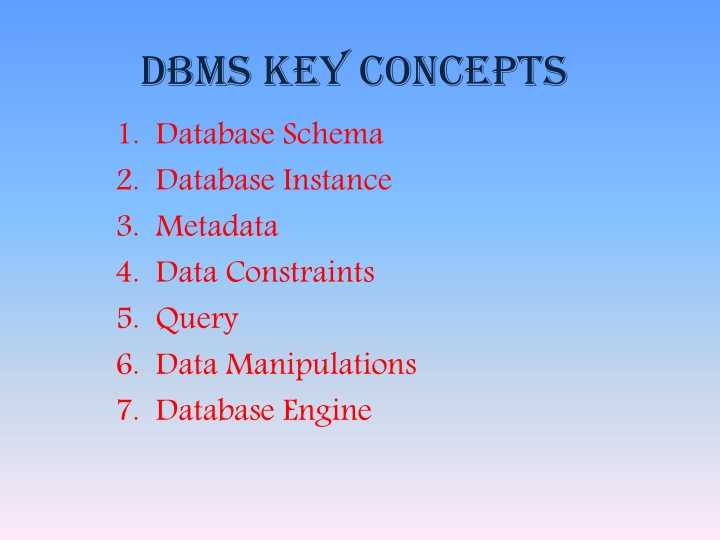
Key Concepts in DBMS - Schema, Instance, Metadata, and More
Explore essential concepts in Database Management Systems (DBMS) such as Database Schema, Database Instance, Metadata, Data Constraints, Queries, Data Manipulations, and more. Learn about the significance of each element in database design and maintenance to enhance your understanding of data organization and management.
Download Presentation

Please find below an Image/Link to download the presentation.
The content on the website is provided AS IS for your information and personal use only. It may not be sold, licensed, or shared on other websites without obtaining consent from the author. If you encounter any issues during the download, it is possible that the publisher has removed the file from their server.
You are allowed to download the files provided on this website for personal or commercial use, subject to the condition that they are used lawfully. All files are the property of their respective owners.
The content on the website is provided AS IS for your information and personal use only. It may not be sold, licensed, or shared on other websites without obtaining consent from the author.
E N D
Presentation Transcript
DBMS Key Concepts 1. Database Schema 2. Database Instance 3. Metadata 4. Data Constraints 5. Query 6. Data Manipulations 7. Database Engine
DATABASE SCHEMA A database schema is a sketch/skeleton/blueprint of a planned data. It represents the design of table columns, relations, constraints and relationships that make up a logically distinct section of a database.
DATABASE INSTANCE A database instance is a snapshot of a database that exists at a particular time, i.e. the data which is stored in the database at a particular moment of time.
METADATA Metadata refers to data about data. Metadata is stored in Data Dictionary. DATA DICTIONARY A data dictionary contains metadata such as the definitions of all schema objects in the database (tables,views,indexes,and all other database objects) along with information.
DATA CONSTRAINTS Data stored in a database must fulfill some rules and conditions so that only validated and required data is stored. The rules and conditions of data are defined via Data Constraints. A database constraint is a set of rules that define valid data. They are NOT CHECK, DEFAULT, FOREIGN KEY. NULL, PRIMARY KEY, UNIQUE,
QUERY A query is a type of command that retrieves data from a database stored on a server. A database query is usually written in SQL ( Structured Query Language)- a specific type of language queries. created specifically for
Data manipulation Data manipulation is the result of action. Data Manipulation takes place when the data in tables is inserted, updated or deleted.
RelationAL Database Model In relational data model, the data is organized into tables (i.e., rows and columns).These tables are called relations. A row in a table represents a relationship among a set of values. Rows of relations are generally referred to as tuples and the columns attributes. are usually referred to
Relational Database Management System The relational model was propounded by E.F. Codd of the IBM. Examples of Relational Database Systems include Microsoft SQL Server, MYSQL, IBM DB2, IBM Informix, SAP Server Enterprise, PostgreSQL, SQLite etc. Management oracle database, Sybase, Adaptive
Components of a Table Byte: A byte is a group of eight bits and is used to store a character. Data Item: A data item is the smallest unit of named data. A data item represents one type of information is known as field. Record: A record is a row or named collection of data items of a person. Table: A table is a collection of rows and columns.
Fields/Columns /Attributes RNO NAME CLASS HOUSE MARKS 1101 AASTHA XII BLUE 98 1102 AKSHAT XI RED 78 Record of a person 1134 RAGHAV X YELLOW 99 1158 SUHANI IX GREEN 86 1160 YUTIKA VIII RED 99 Require 6 bytes Tuple: Rows of a table Attributes: Columns of a table Degree: The number of columns of a table(5) Cardinality: The number of rows of a table(5)

